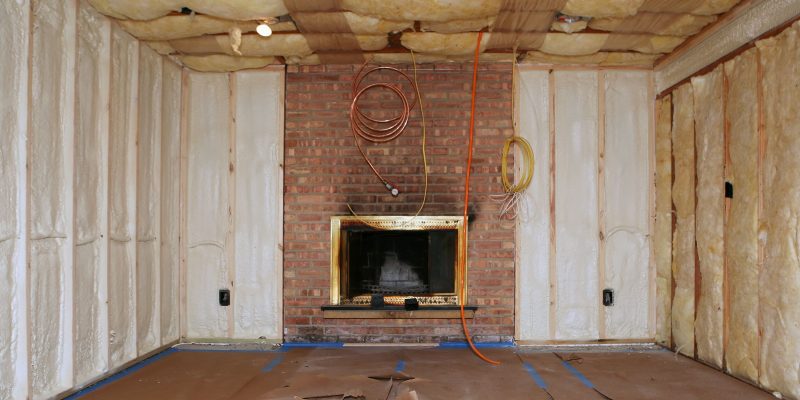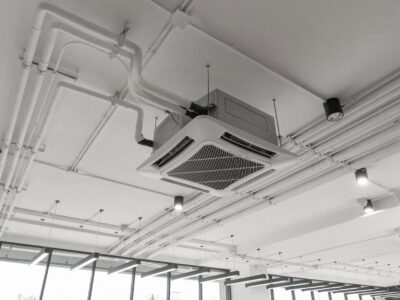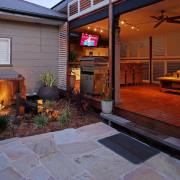Heating your house can get very expensive, especially if you have an uninsulated basement. Although hot air rises, an unfinished basement can still cause significant heat loss, costing more money and poor temperature control throughout the upper floors. There are other concerning issues to consider, such as pipes bursting because they have frozen in low temperatures. However, all is not lost. In case if you have an underground room, make sure that the system is insulated correctly and using a supplemental heating system, your basement has the potential to be the warmest room in the house.
One of the main causes of a cold basement is chilly drafts. It may seem like the best solution is to try and turn the heat up, but this won’t be sufficient if all of the warm air is escaping through cracks and windows. A cold room can be pretty unappealing and won’t encourage you or your family to spend time in the basement. You could be missing out on a versatile room on your property.
If you’re not a DIY expert, there’s no need to fear! There are lots of easy things that you can do to insulate your basement and save energy. You can also invest in some extra heating systems as a guaranteed way to provide extra warmth during the winter months.
Below are a few ways that you can regulate the temperature in your underground room and ensure that you’re not paying a fortune on your heating bill.
What are the best ways to heat an underground room?
The easiest way to heat an underground room is to make sure the space is properly insulated. This could mean replacing windows to reduce drafts or adding foamboards and foam glass to the walls
Another great way to increase the temperature in the basement is to install heaters. There are a variety of heaters that can provide adequate warmth to your underground room, such as space, ceramic or oil heaters.
Read on for more in-depth tips on what to look out for when insulating your basement and the materials and equipment to use.
Replacing the windows
One of the quickest ways to lose warm air in any room is through the windows. Natural lighting can really open up a space and make it more inviting, but it’s important not to sacrifice the heating efficiency of the room.
Check for any gaps or cracks where cold air might be blowing in or warm air escaping. You can spray low expansion insulating foam around the edges of the window to seal the gaps and prevent heat loss. High expansion foam might have the opposite effect of what you’re trying to achieve because it might put too much pressure on the window and make it difficult to open.
Windows are also an important factor in airflow, especially if your room is prone to collecting unwanted smells. It’s important that the windows can be opened easily, to allow for ventilation and fresh air into the room.
Double or triple glazing is an effective way to contain the room’s warmth as well as keeping cool air out. Single glazed windows are renowned for causing a high percentage of heat loss as they are highly conductive. This means that cold air is let in during the winter and stifling hot air in the summer months. It’s important that you check and maintain the windows regularly, otherwise, they can cause a moisture build-up, which can lead to other problems such as mould. There’s nothing worse than a cold, damp room, especially in the depths of winter.
Insulating the walls
It might sound complicated, but insulating your basement walls is surprisingly straightforward and can save you lots of money in the long run. The first thing that you’ll need to check is whether your basement has a problem with leaking water or mould. This will need to be resolved before any insulation work takes place. Once you’ve made sure that the walls are dry, you can consider the material of choice for your work.
You can line the concrete walls with material such as foamboards. This can be in the form of closed-cell extruded polystyrene. It’s one of the cheaper methods and a favourite amongst most people doing DIY due to its easy application. You can cut the pieces to size using a utility knife to score the desired size and then snap to break the pieces off. The boards can be attached via screws with large washers or an adhesive tape that is specifically designed for the material.
For basements that aren’t known to have any water leaks, it’s worth considering foam glass. As with foamboards, this material will help to create an extra layer to keep the warm air contained and increase the constant temperature of the room. It’s important that the sections of insulation fit to the wall snugly, without any gaps.
If you want the insulation to be a permanent fixture, you could also construct a timber frame to keep the pieces in place against the concrete wall. It’s important that the basement wall stays dry, which is why ordinary polystyrene or fibreglass aren’t suitable materials. They will eventually get a build-up of moisture, which can affect the effectiveness of their purpose.
If you’re willing to spend a bit more on insulating, you might consider using spray foam. This material has become increasingly popular in recent years due to its flexibility and effective results. The foam can be applied directly to fill voids and gaps within the walls and to create an air seal. Unlike other forms of insulating material, spray foam doesn’t have to be maintained or replaced, which will save you even more money in the long run.
There are two kinds of liquid foam – closed-cell and open-cell spray. Open-cell foam has cells that aren’t completely closed and are filled with air. Closed-cell foam is less breathable because the cells are sealed off so air can’t get inside. Closed-cell also has a lower thermal conductivity and is less likely to allow air or water leakage. Open-cell spray is cheaper, but as it’s softer, it doesn’t have the added bonus of helping with stability to the property. Spray foam should be applied by a professional due to the damage that can be caused to the property if applied incorrectly.
Insulating the ceiling
Insulating the ceiling might not significantly improve the temperature in your basement as much as the walls, but it may be something to consider depending on the severity of the chill in your basement. As most people know, warm air rises, so the ceiling can be an important area to look at when trying to keep the warmth contained in the basement. It will also maintain an even temperature between the basement and the rooms above.
Once you have made sure that the framework of the ceiling is in a good condition, you can apply spray foam and rigid foam to the ceiling. As mentioned previously in the article, liquid foam is long-lasting and requires little to no maintenance. However, it is important to get an expert opinion before considering this solution as the foam requires a special application and is very hard to remove once it has been fitted. The dry foam will prevent any drafts and will also create an air seal. This can help keep the warm air in the basement, although it does have the possible side effect of poor ventilation.
You’ll have to work around the framework, various wires, and pipes to make sure that the insulation covers the area completely. It’s very important to cover the rim joists, which are the primary structural elements that provide support to the framework. You can identify the rim joists by looking for wooden squares that go around the perimeter of the ceiling.
By applying spray or rigid foam to the ceiling, any gaps will be sealed, which will prevent hot air from escaping. It should also help increase the temperature of the flooring in the main house and help with the energy efficiency. Sealing the gaps can also reduce the number of bugs and pests that will try and make their way into your home.
A con of insulating the ceiling is the increased chance of condensation as there will be limited airflow from the house above. In this instance, it’s even more important to make sure that your windows are regularly opened and allow consistent ventilation.
Install radiant floor heating
Radiant floor heating may seem like a modern invention, but it actually uses technology that goes back thousands of years. In fact, it was a common feature in most Roman houses. This heating method focuses on warming the objects and people in a room from the ground up, rather than just heating the air.
Underfloor heating is best suited to natural materials, so stone or tile flooring is perfect. These natural materials have heat-conductive properties, which allows the heat to spread evenly over the area and keep the room nice and warm.
Underfloor heating is often more efficient than radiators because of the larger area that they heat. This means that the room will feel warmer in a shorter space of time and stay at the same temperature for longer. Radiators only emit heat into the air directly around them, meaning that there can be cold spots left in the room. Radiant floor heating runs at a lower temperature, but they heat the room equally from the floor up, providing a consistent temperature throughout.
The initial installation may be expensive, but you’ll be able to save money in the long run by saving electricity money on radiators and heaters. You’ll also receive controllable temperatures in your basement, which will help the temperature control throughout the upper levels of your house. It will also result in much better air quality because the minimal air movement won’t circulate dust and allergens.
Water-based and electric are the two most commonly used methods for underfloor heating. Electric radiant floor heating is the better option for your basement as it can be used for smaller projects and doesn’t have to be installed at the building stage of a house. The result is heating that is consistent and usually cheaper to run as it won’t use as much energy.
If you’ve got a combi boiler, you can still get underfloor heating but it will require some adjustments. You can hire an engineer to install a two-port valve, which can redirect the water flow that goes to the boiler and radiators of your house to the underfloor pipes.
Install heaters
Installing heaters in your basement is an easy way to increase the overall temperature of your house and keep your basement warm (provided the room is fully insulated). There’s a variety of space and electric heaters that you can choose from to suit your needs and provide instant heat to your basement. They are usually hassle-free to install and come in a variety of sizes to fit your room.
The most common styles used in houses are ceramic, oil and infrared. Ceramic and oil heaters rely upon fans spreading the heated air, whereas infrared heaters transfer energy through electromagnetic radiation, similar to how the sun radiates heat. Although they use slightly different technology, they all run on electricity and are easy to maintain. You can also find heaters that allow you to customise the temperature, whereas others will come with a pre-set temperature.
Heaters have many other benefits aside from warming your basement. They will help prevent condensation and mould growth, which can help improve the air quality of the room. They are often portable and take up limited space, which is ideal for smaller basements.
For larger basements, it’s usually better to consider your current HVAC (heating, ventilation, and air conditioning) system and adapt it to control the temperature and humidity of your underground room. Heaters won’t emit enough heat to make a significant difference to the current temperature of the room. It will save you both heat and money when considering the size of your basement and whether or not smaller heaters will work for you.
Geothermal Heating
If you’re looking for a solution for a larger property, then geothermal heating could be for you. Using the natural properties of the earth, geothermal heating helps to create a heat source in the winter and can be used as a heat sink in the summer months.
A ground pump is installed in the earth and extracts heat to transfer it to the property. This method can be reversed in hotter months by taking the hot air from your home, transferring and then using the ground’s colder temperatures to emit cooler air into your home. Not only can this installation save you money, but the technique emits no carbon emissions, which means you’ll be helping the planet at the same time.
As expected, this type of installation will need to be completed by a professional. Geothermal heating is one of the more expensive solutions and would only be worthwhile in a larger property with poor insulation to see any return on the investment. Having said that, they are cheaper to run than electric heating systems and safer than combustion-based heating systems due to no emission of potentially dangerous gases.
Geothermal heating is a great way to provide comfortable temperatures in your house year-round, as well as provide long-lasting sustainable energy to your property.
Build a fireplace
Similarly to heaters, fireplaces can be a good source of warmth in your basement. Not only are they functional, but fireplaces also add a comforting aesthetic to what can otherwise be a drab room. They’re not always an option depending on the layout of your basement, but they’re worth considering if your space is large or ventilated enough.
There are certain safety precautions to consider when building a fireplace in your underground room. For one, if you choose a traditional wood or gas option, you will need ventilation to allow fresh air from outside to reach your fireplace. This will prevent a build-up of smoke or carbon dioxide. You won’t necessarily require a chimney, but you will need a direct vent system. It’s also worth considering the cleaning aspect of a traditional fireplace, as you will need to deposit the ashes and regularly bring wood down to the room.
The upfront cost of installing a traditional fireplace might seem daunting but the long term effect can be cost-effective as it will heat your room without adding to your electricity bill.
Alternatively, electric fireplaces offer the same pleasing visuals, but are easier to maintain than a traditional one and don’t require as much monitoring. There won’t be the fumes or mess that accompanies a traditional fireplace, although they will increase your electricity bill, especially if used frequently.
To summarise, there are a variety of ways to make sure your basement stays at a consistent temperature throughout the year. Not only can you stay warm during the winter months, but you might find yourself saving money on the bills too.














Comments